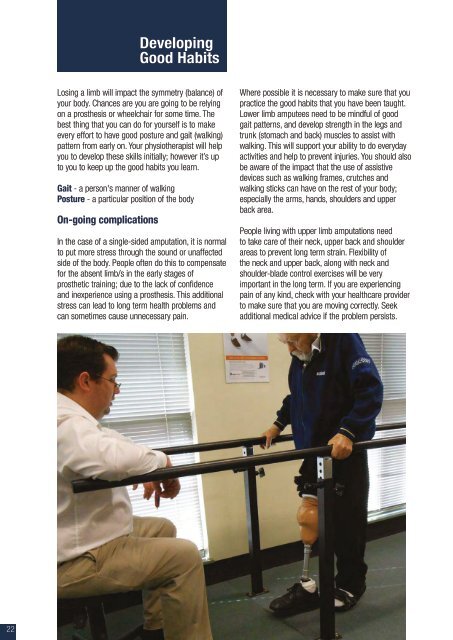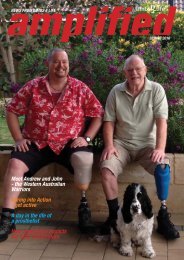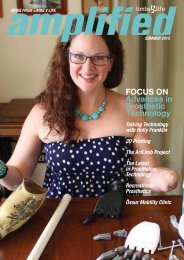A PRACTICAL
A%20Practical%20Guide%20for%20Amputees%20-%20Limbs%204%20Life
A%20Practical%20Guide%20for%20Amputees%20-%20Limbs%204%20Life
You also want an ePaper? Increase the reach of your titles
YUMPU automatically turns print PDFs into web optimized ePapers that Google loves.
Developing<br />
Good Habits<br />
Losing a limb will impact the symmetry (balance) of<br />
your body. Chances are you are going to be relying<br />
on a prosthesis or wheelchair for some time. The<br />
best thing that you can do for yourself is to make<br />
every effort to have good posture and gait (walking)<br />
pattern from early on. Your physiotherapist will help<br />
you to develop these skills initially; however it’s up<br />
to you to keep up the good habits you learn.<br />
Gait - a person's manner of walking<br />
Posture - a particular position of the body<br />
On-going complications<br />
In the case of a single-sided amputation, it is normal<br />
to put more stress through the sound or unaffected<br />
side of the body. People often do this to compensate<br />
for the absent limb/s in the early stages of<br />
prosthetic training; due to the lack of confidence<br />
and inexperience using a prosthesis. This additional<br />
stress can lead to long term health problems and<br />
can sometimes cause unnecessary pain.<br />
Where possible it is necessary to make sure that you<br />
practice the good habits that you have been taught.<br />
Lower limb amputees need to be mindful of good<br />
gait patterns, and develop strength in the legs and<br />
trunk (stomach and back) muscles to assist with<br />
walking. This will support your ability to do everyday<br />
activities and help to prevent injuries. You should also<br />
be aware of the impact that the use of assistive<br />
devices such as walking frames, crutches and<br />
walking sticks can have on the rest of your body;<br />
especially the arms, hands, shoulders and upper<br />
back area.<br />
People living with upper limb amputations need<br />
to take care of their neck, upper back and shoulder<br />
areas to prevent long term strain. Flexibility of<br />
the neck and upper back, along with neck and<br />
shoulder-blade control exercises will be very<br />
important in the long term. If you are experiencing<br />
pain of any kind, check with your healthcare provider<br />
to make sure that you are moving correctly. Seek<br />
additional medical advice if the problem persists.<br />
22




